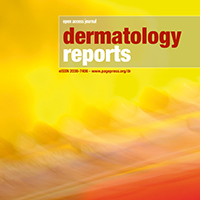Tinea incognito: Clinical perspectives of a new imitator

Accepted: 23 May 2020
HTML: 299
All claims expressed in this article are solely those of the authors and do not necessarily represent those of their affiliated organizations, or those of the publisher, the editors and the reviewers. Any product that may be evaluated in this article or claim that may be made by its manufacturer is not guaranteed or endorsed by the publisher.
Tinea incognito is a variant of dermatophyte infection of the skin modified by an erroneously applied topical or systemic steroid. Aim of the study: to describe the various clinic-epidemiological aspects of tinea incognito found among our patients. A prospective study was carried out in the Department of Dermatology, Basra Teaching Hospital, Basra, Iraq. The clinical diagnosis was confirmed by mycological tests. Clinical data were described in more detail and the lesions were classified according to the site, shape, and extent. Ninety cases of tinea incognito were seen, median age was 34years. The initial inaccurate diagnoses were eczema in 60 patients (67%), intertrigo in 16 (18 %) and psoriasis in 14 (15%) patients. The type of topical drugs applied was topical corticosteroid (potent and fluorinated) in most cases (54.4%), fixed drug combination creams in 36.6% and a topical calcineurin inhibitor in 5.5%. Commonly presented as acute eczema-like, on hands and trunk, discoid lupus erythematosus-like lesions on the face and psoriasiform lesions on the scalp. Due to the wide range of clinical manifestations, tinea incognito imitates many skin diseases and should, therefore, be considered in any chronic, erythematous, scaly skin lesions not responding to topical treatment.
2- Romano C, Maritati E, Gianni C. Tinea incognito in Italy: a 15-year survey. Mycoses 2006;49:383-387.
3- Agostini G, Knopfel B, Difonzo EM. Universal dermatophytosis (tinea incognito) caused by Trichophyton rubrum. Hautarzt 1995; 46:190–193.
4- Guenova E, Hoetzenecker W, Schaller M, Rocken M, Fierlbeck G. Tinea incognito hidden under apparently treatment-resistant pemphigus foliaceus. Acta Derm- Venereol 2008;88:276-277.
5- Feder HM. Tinea incognito misdiagnosed as erythema migrans. New Engl J Med 2000; 343: 69.
6- Solomon BA, Glass AT, Rabbin PE. Tinea incognito and “over-the-counter” potent topical steroids. Cutis.1996;58(4):295-6.
7- Siddalah N, Erickson O, Miller G, Elston DM. Tacrolimus induced Tinea incognito. Cutis.2004;73(4):237-8.
8- Abed Ali F, Jawad K. Al-Janabi A, Alhattab M. Prevalence of dermatophyte fungal infection in Hillah, Iraq. Int J Chem Tech Res, 2017,10(6): 827-837.
9- Jowkar F, Saki N, Derayesh M, Aslani FS Tinea incognito simulating dermatitis herpetiformis: An unusual case report. Iran J Dermatol2016; 19:54-56.
10- Kim W, Tae-Wook Kim T, Je-Ho Mun J, Song M, Kim HS. Tinea Incognito in Korea and Its Risk Factors: Nine-Year Multicenter Survey. J Korean Med Sci.2013; 28: 145-151
11-Verma S, Madhu R. The great Indian epidemic of superficial dermatophytoses: An appraisal. Indian J Dermatol. 2017;62:227-36.
12- Al-Dhalimi M, Aljawahiry N. Misuse of topical corticosteroids: a clinical study in an Iraqi hospital. E Mediterr Health J 2006, 12(6):847- 852.
13- Degreef H, Doncker P(editors). Fighting Fungal Infection Around the Globe: Itraconazole in Perspective. Kent, UK: Wells Medical Holdings,2000.
14- Ansar A, Fershchian M, Naseri H, Ghiasian SA. Clinico-epidemiological & mycological aspects of tinea incognito in Iran: a 16-years study. Med Mycol J.2011;52:25-32.
15- Erbagci Z. Topical therapy for dermatophytoses: should corticosteroids be included?. Am J Clin Dermatol.2004;5(6): 375-384.
PAGEPress has chosen to apply the Creative Commons Attribution NonCommercial 4.0 International License (CC BY-NC 4.0) to all manuscripts to be published.





 https://doi.org/10.4081/dr.2020.8323
https://doi.org/10.4081/dr.2020.8323



